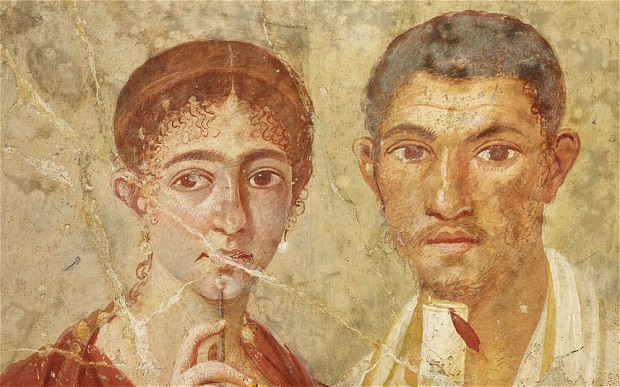Published by ConservativeHome
 Of all the cities of antiquity, Pompeii is quite possibly the best known. “It was lost, and is now found; it was destroyed, and is now preserved.” Frozen in time, it provides a unique
Of all the cities of antiquity, Pompeii is quite possibly the best known. “It was lost, and is now found; it was destroyed, and is now preserved.” Frozen in time, it provides a unique
window on Roman cultural and intellectual life, and holds a mirror up to so many of our own attitudes, features, gestures and obsessions.
My fascination with the city and its catastrophic destruction goes back to childhood: I recall in my Latin textbook Ecce Romani pictures of a dog mosaic and a weird skeleton: ‘canis ferocissimus est.’ And frescos of Caecilius and his family: ‘Caecilius iterum clamavit.’ I was an avid collector of postcards, guidebooks and magazines on the topic. I had read Pliny’s harrowing account and Lord Lytton’s The Last Days of Pompeii by the age of 13: ‘Quid sit futurum cras, fuge quaerere.’ Supping with Glaucus and gambling with Clodius are what all schoolchildren should be doing, instead of sexting their friends and surfing the internet in a cyber-life of meaningless meandering.
I eventually got to visit Pompeii and Herculaneum leading a GCSE Classics group there a few years ago, and was finally able to see and touch that famous ‘Cave canem’ mosaic, walk through the exotic bathhouses, and buy my very own bronze statue of a dancing faun. I also visited the Naples Museum to satisfy my curiosity of all those naughty erotic pieces of statuary so carefully screened from innocent eyes (though Year 10 weren’t remotely fazed by any of it).
With that authentic experience, I was in two minds as to whether I should visit the British Museum’s exhibition ‘Life and Death in Pompeii and Herculaneum’, which has had a mixed reception. Those who loved it invariably admired the gruesome preservation of life and agonising death; those who loathed it seem to complain about the stifling heat in a dreary, airless space full of sweaty bodies, children crying and exasperated mothers trying to escape the claustrophobic blackness. Pretty much, in fact, what first-century Pompeii would have been like.
When I finally managed to get tickets a few weeks ago, yes, I found myself in a superheated sauna of pyroclastic gases, trampled underfoot by tens of thousands of tourists. But the thermal shock and discomfort were worth it to get a sense of just how suddenly the domestic harmony and community frenzy of one balmy August day in AD 79 can be so suddenly engulfed by an apocalyptic image of horror. You just don’t get that walking leisurely around the satyred gardens of Campania.
Elegant villas, rooms adorned with exquisite paintings, gardens with fountains, all reconstructed to bring alive a lost world in sensuous detail. There were kitchen saucepans and cooking utensils; pitchers, plates and goblets; a charred children’s cot and a carefully-crafted storage chest with melted brass fixtures. It was all so much more immediate and intense than visiting the real thing at the height of the Amalfi tourist season.
There were pictures and portraits, sculpted marble statues, and murals in vivid scarlet and pastel shades of pastoral tranquility. There was even real food – carbonised olives and nuts and petrified bread – all carefully prepared by Sotericus for an imminent feast, but never finally eaten in the villa of Diomedes or the house of Loreius Tiburtinus.
It is essentially an exhibition of artefacts, but you get a vivid sense of the real people who bartered in the Forum; stood for political office; scrawled their graffiti and vulgar inscriptions on the walls of the local bar; and who grunted their moments of ecstasy in the brothels, intoxicated (quite literally) on Bacchus-worship. The imperial cult had a special place in the religious life of Pompeii. Its hierarchy of priests and priestesses participated in the celebration of the divinity of the Emperor, and so held prominent positions in Pompeian society. But, as was in the days of Noah, they were all oblivious to the Great Day of Wrath that was about to consume them.
As Vesuvius belched out its sulphur and steam 20 miles into the atmosphere, some 20,000 people beneath were scorched to death or reduced to ash. Over the ensuing hours, the hubbub, prosperity and opulence of Pompeii and Herculaneum would be entombed beneath metres of volcanic residue and molten basalt, waiting to be discovered almost two millennia later. You can but stare in wonder at the twisted plaster cast of an entire family preserved in a moment of terror – the ghosts of a husband shielding his face and a mother grasping her children to defend them from the fires of Orcus.
This is the stuff of living history: not only does it still inform our own architecture, art and interior design, it keeps the likes of Mary Beard in a full-time job, and civilisation is all the better for that. It’s just a pity that so many schools long ago dropped Latin for Home
Economics, exchanged Greek for Drama, and shunted out Classical Civilisation in favour of Media Studies. Lytton’s The Last Days of Pompeii has it all, and more. And the British Museum’s ‘Life and Death in Pompeii and Herculaneum’ would enthral any who are fascinated with at the original Ground Zero.
